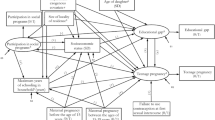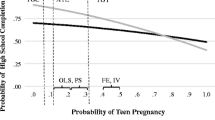Abstract
This study analyzed the roles of trends in sociodemographic factors known to be related to the risk of a teen birth. The goal was to analyze the roles of these trends in maternal education, family structure and mother’s age at first birth in the likelihood of adolescents becoming teen mothers across multiple birth cohorts of women covering the years since 1991. Data are from the 1995, 2002, 2006–2010 and 2011–2013 National Surveys of Family Growth (NSFG). Consecutive birth cohorts of female respondents were constructed and retrospectively followed to estimate the risk of a teen birth for each cohort. Logistic regression models estimate the odds of a teen birth across cohorts and within strata of the predictors across cohorts. Maternal education rose across cohorts; the proportion who were non-Hispanic white declined. In general, the likelihood of an adolescent birth did not change within categories of the predictors that are considered at higher risk for a teen birth across birth cohorts. Specifically, there was no change in the odds of a teen birth among women whose mothers did not finish high school, those born to teen mothers and those not from two-parent families. The odds of a birth declined across cohorts for black women. The findings suggest that much of the decline in teen birth rates is due to declines in the proportion of teens in higher risk categories, rather than to declines within those categories.


Similar content being viewed by others
References
Francesconi, M. (2008). Adult outcomes for children of teenage mothers. The Scandinavian Journal of Economics, 110(1), 93–117.
Klepinger, D., Lundberg, S., & Plotnick, R. (1999). How does adolescent fertility affect the human capital and wages of young women? The Journal of Human Resources, 34(3), 421–448.
Lee, D. (2010). The early socioeconomic effects of teenage childbearing: A propensity score matching approach. Demographic Research, 23, 697–736.
Jutte, D. P., Roos, N. P., Brownell, M. D., Briggs, G., MacWilliam, L., & Roos, L. L. (2010). The ripples of adolescent motherhood: Social, educational, and medical outcomes for children of teen and prior teen mothers. Academic Pediatrics, 10(5), 293–301.
Levine, J. A., Emery, C. R., & Pollack, H. (2007). The well-being of children born to teen mothers. Journal of Marriage and Family, 69(1), 105–122.
Hoffman, S. D., & Maynard, R. A. (Eds.). (2008). Kids having kids: Economic costs and social consequences of teen pregnancy (2nd ed.). Washington, DC: Urban Institute Press.
Ventura, S. J., Hamilton, B. E., & Mathews, T. J. (2014). National and state patterns of teen births in the United States, 1940–2013. National Center for Health Statistics. National Vital Health Stat Report. 63 No. 4.
Martin, J. A., Hamilton, B. E, Ventura, S. J., Osterman, M. J. K., Kimeyer, S., Mathews, T. J., & Wilson, E. C. (2011). Births: Final Data for 2009. National Center for Health Statistics. National Vital Stat. Reports 60(1).
Hamilton, B. E., & Ventura, S. J. (2012). Birth rates for U.S. teenagers reach historic lows for all age and ethnic groups. National Center for Health Statistics, Data Brief, No. 89.
Manlove, J., Ikramullah, E., Mincieli, L., Holcombe, E., & Danish, S. (2009). Trends in sexual experience, contraceptive use, and teenage childbearing: 1992–2002. Journal of Adolescent Health, 44(5), 413–423.
Hofferth, S. L., & Goldscheider, F. (2010). Family structure and the transition to early parenthood. Demography, 47(2), 415–437.
Meade, C. S., Kershaw, T. S., & Ickovics, J. R. (2008). The intergenerational cycle of teenage motherhood: An ecological approach. Health Psychology, 27(4), 419–429.
U.S. Census (2011). http://www.census.gov/hhes/socdemo/education/data/cps/historical/index.html. Accessed March 2012.
Albrecht, C., & Teachman, J. D. (2003). Childhood living arrangements and the risk of premarital intercourse. Journal of Family Issues, 24(7), 867–894.
Harris, K. M., Duncan, G. J., & Boisjoly, J. (2002). Evaluating the role of “nothing to lose” attitudes on risky behavior in adolescence. Social Forces, 80(3), 1005–1039.
Hogan, D. P., Sun, R., & Cornwell, G. T. (2000). Sexual and fertility behaviors of American females aged 15–19 years: 1985, 1990, and 1995. American Journal of Public Health, 90(9), 1421–1425.
Kirby, D. (2002). Antecedents of adolescent initiation of sex, contraceptive use, and pregnancy. American Journal of Health Behavior, 26(6), 473–485.
Martinez, G., Copen, C. E., & Abma, J. A. (2011). Teenagers in the United States: Sexual activity, contraceptive use, and childbearing, 2006–2010 National Survey of Family Growth. National Center for Health Statistics. Vital and Health Statistics, 23(31), 1–35.
Miller, B. C., Norton, M. C., Curtis, T., Hill, E. J., Schvaneveldt, P., & Young, M. H. (1997). The timing of sexual intercourse among adolescents: Family, peer, and other antecedents. Youth and Society, 29(1), 54–83.
Upadhya, K. K., & Ellen, J. M. (2011). Social disadvantage as a risk for first pregnancy among adolescent females in the United States. Journal of Adolescent Health, 49(5), 538–541.
An, C.-B., Haveman, R., & Wolfe, B. (1993). Teen out-of-wedlock births and welfare receipt: The role of childhood events and economic circumstances. The Review of Economics and Statistics, 75(2), 195–208.
Dehlendorf, C., Marchi, K., Vittinghoff, E., & Braveman, P. (2010). Sociocultural determinants of teenage childbearing among Latinas in California. Maternal and Child Health Journal, 14(2), 194–201.
Substance Abuse and Mental Health Data Archives (SAMHDA). http://www.icpsr.umich.edu/icpsrweb/SAMHDA/ssvd/studies?display=verbose&q=+mother%27s+education. Accessed March 2012.
Manlove, J., Terry, E., Gitelson, L., Papillo, A. R., & Russell, S. (2000). Explaining demographic trends in teenage fertility, 1980–1995. Family Planning Perspectives, 23(4), 166–175.
Donahue, K. L., D’Onofrio, B. M., Bates, J. E., Lansford, J. E., Dodge, K. A., & Pettit, G. S. (2010). Early exposure to parents’ relationship instability: Implications for sexual behavior and depression in adolescence. Journal of Adolescent Health, 47(6), 547–554.
Wu, L. L., & Martinson, B. C. (1993). Family structure and the risk of a premarital birth. American Sociological Review, 58, 210–232.
Furstenberg, F. F., Levine, J. A., & Brooks-Gunn, J. (1990). The children of teenage mothers: Patterns of early childbearing in two generations. Family Planning Perspectives, 20(2), 54–61.
Kahn, J. R., & Anderson, K. E. (1992). Intergenerational patterns of teenage fertility. Demography, 29(1), 39–57.
Ventura, S. J. (1984). Trends in teenage childbearing, United States, 1970–1981. National Center for Health Statistics. Vital Health Stat Report. 21 No. 41.
Brooks-Gunn, J., & Duncan, G. J. (1997). The effects of poverty on children. The future of children, 7(2), 55–71.
Gold, R., Kennedy, B., Connell, F., & Kawachi, I. (2002). Teen births, income inequality, and social capital: Developing an understanding of the causal pathway. Health & Place, 8, 77–83.
Hobcraft, J., & Kiernan, K. (2001). Childhod poverty, early motherhood and adult social exclusion. British Journal of Sociology, 52(3), 495–517.
Kalil, A., & Kunz, J. (1999). First births among unmarried adolescent girls: Risk and protective factors. Social Work Research, 23(3), 197–208.
South, S. J., & Crowder, K. (2010). Neighborhood poverty and nonmarital fertility: Spatial and temporal dimensions. Journal of Marriage and Family, 72(1), 89–104.
National Center for Health Statistics (NCHS). (2011). 2006–2010 User’s Guide. Hyattsville, MD. http://www.cdc.gov/nchs/nsfg/nsfg_2006_2010_puf.htm.
Cubbin, C., Santelli, J., Brindis, C. D., & Braveman, P. (2005). Neighborhood context and sexual behaviors among adolescents: Finding from the national longitudinal study of adolescent health. Perspectives on Sexual and Reproductive Health, 37(3), 125–134.
McNeely, C., Shew, M. L., Beuhring, T., Sieving, R., Miller, B. C., & Blum, R. W. (2002). Mothers’ influence on the timing of first sex among 14- and 15-year-olds. Journal of Adolescent Health, 31(3), 256–265.
U.S. Census (2013). http://www.census.gov/hhes/socdemo/education/data/cps/historical/index.html. Accessed July 2013.
Author information
Authors and Affiliations
Corresponding author
Rights and permissions
About this article
Cite this article
Driscoll, A.K., Abma, J.C. Changing Sociodemographic Factors and Teen Fertility: 1991–2009. Matern Child Health J 19, 2159–2167 (2015). https://doi.org/10.1007/s10995-015-1728-8
Published:
Issue Date:
DOI: https://doi.org/10.1007/s10995-015-1728-8




